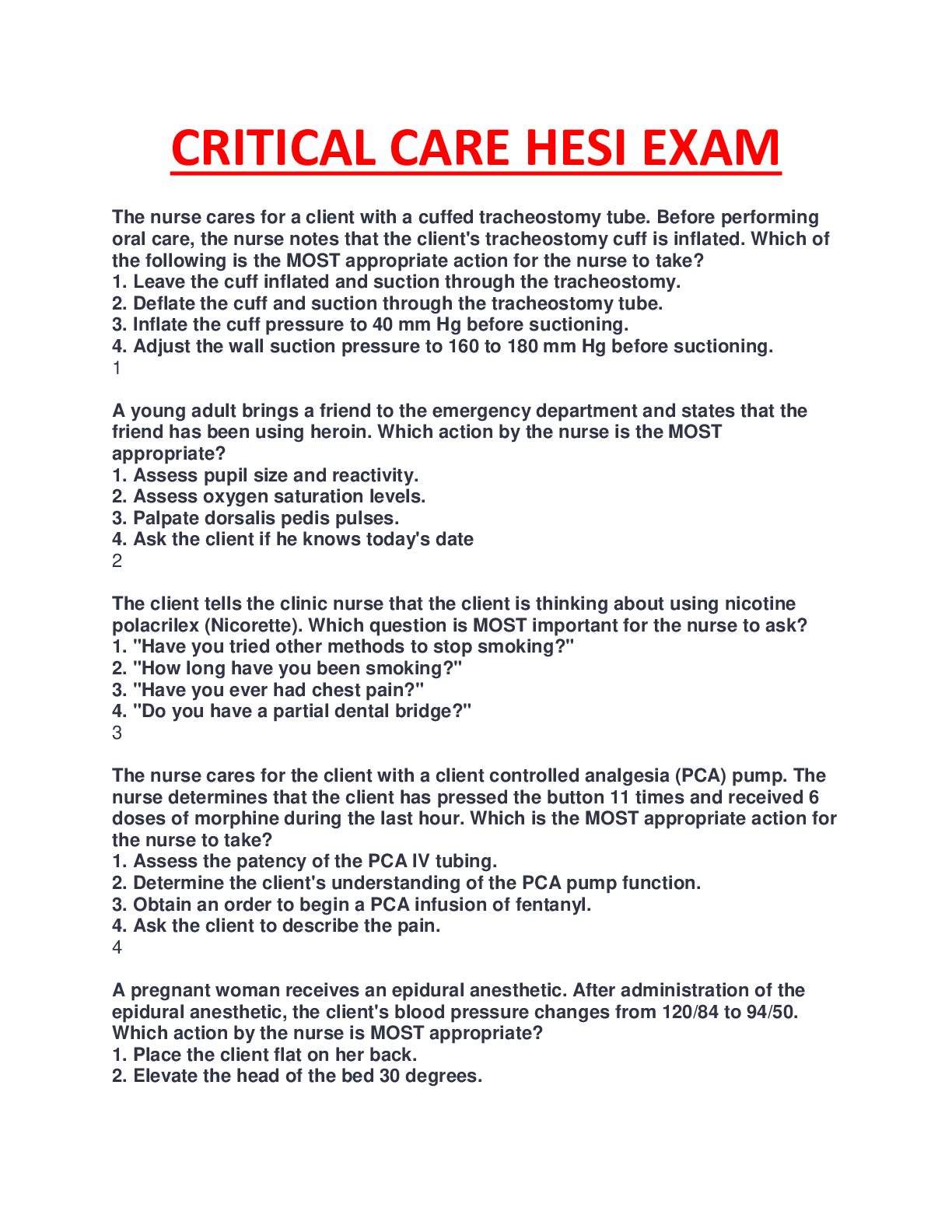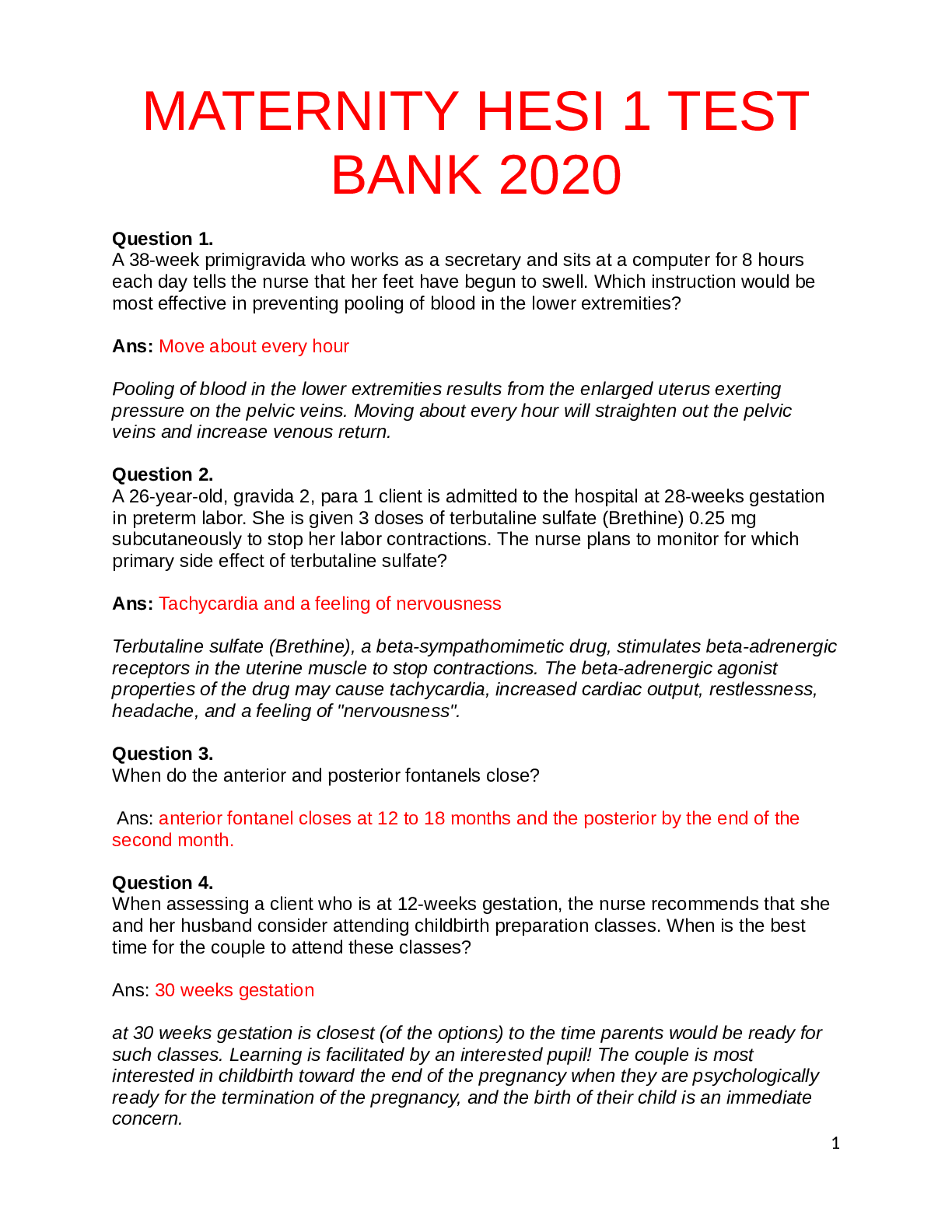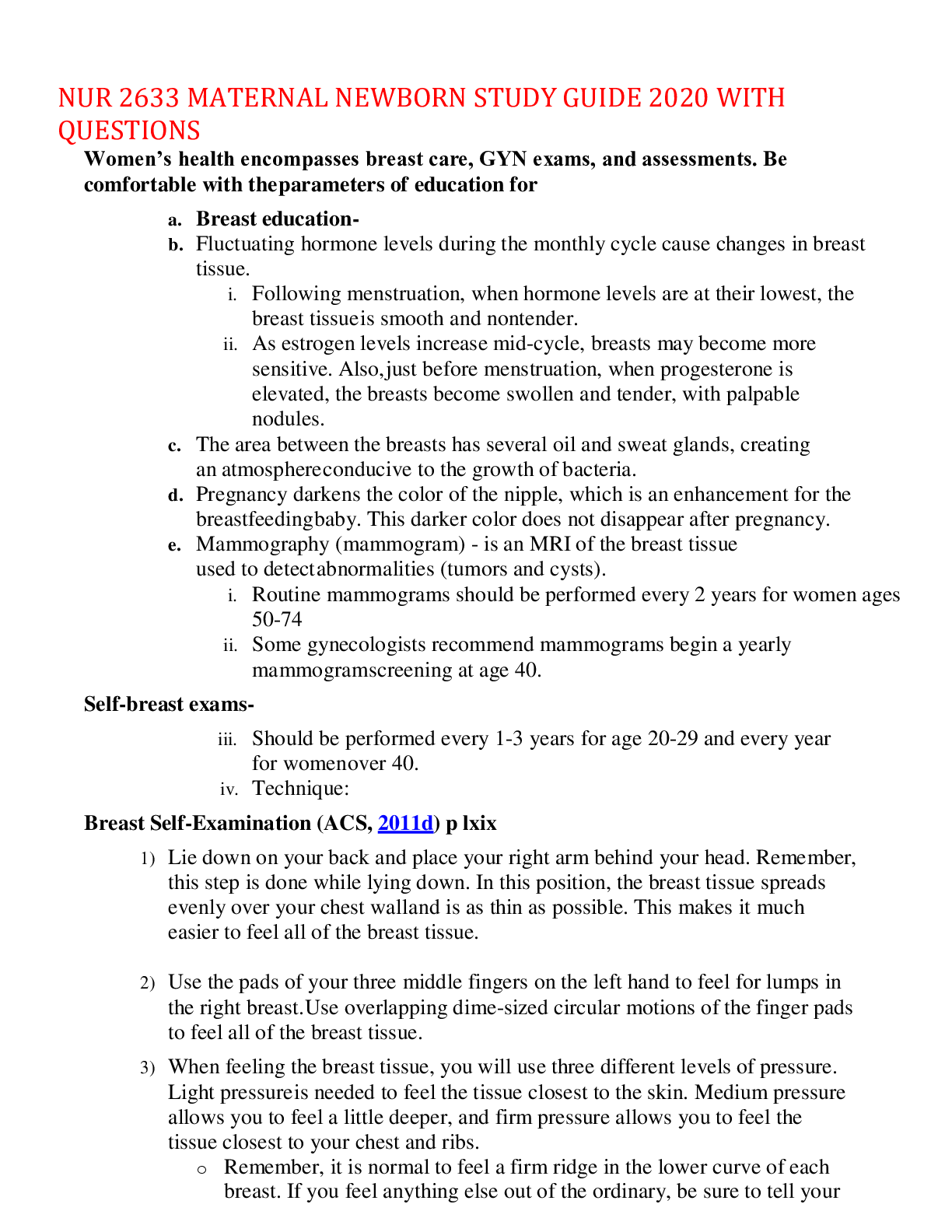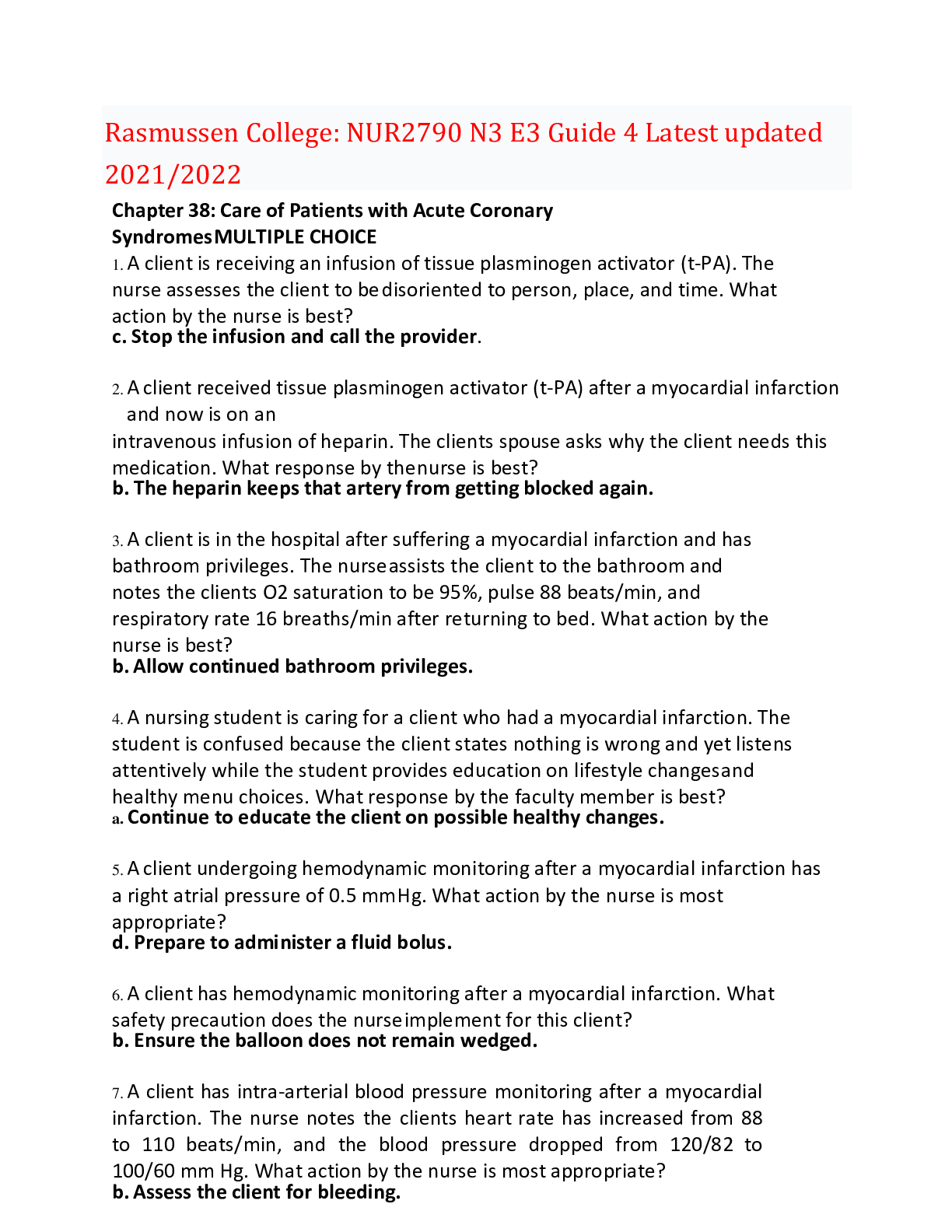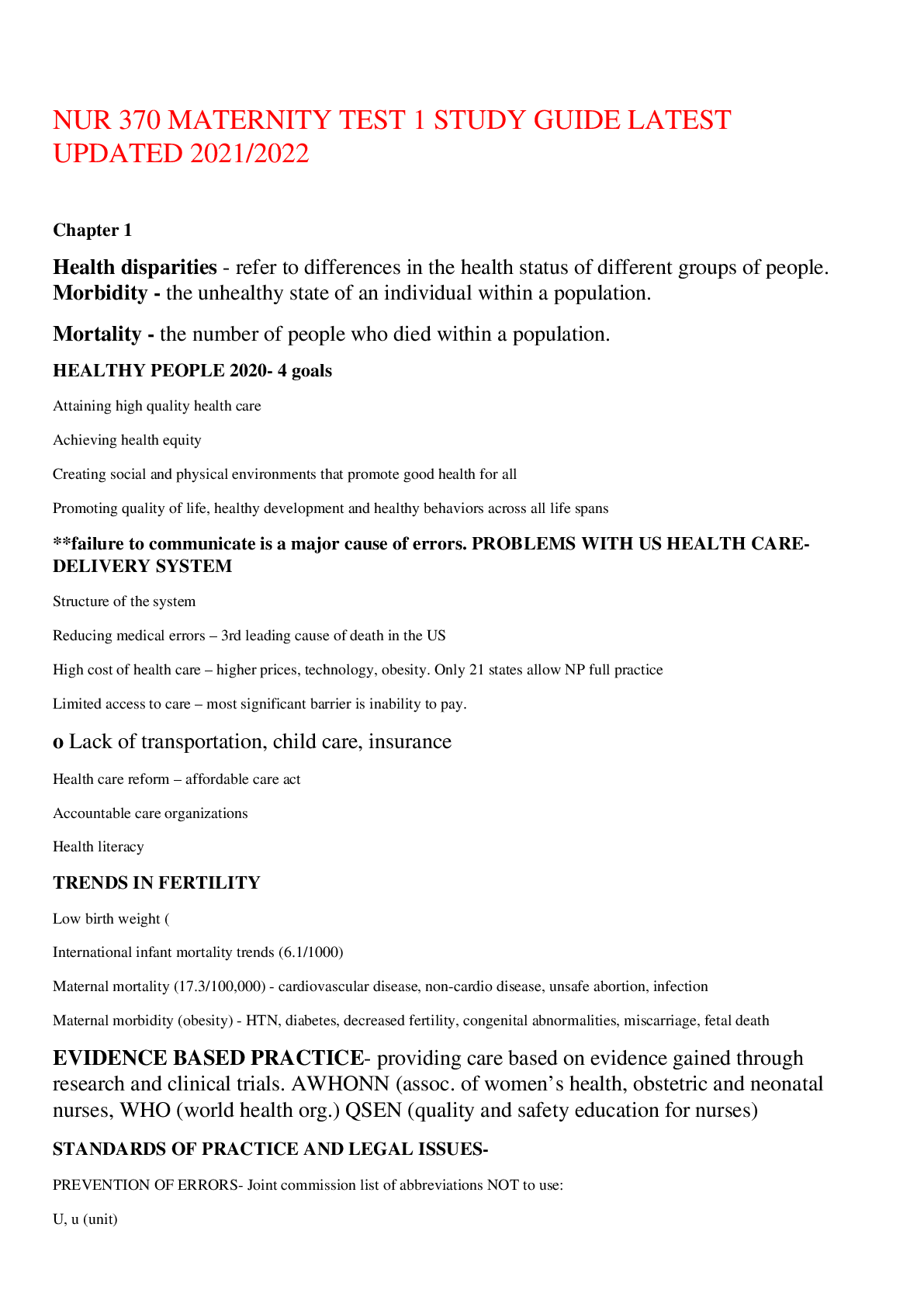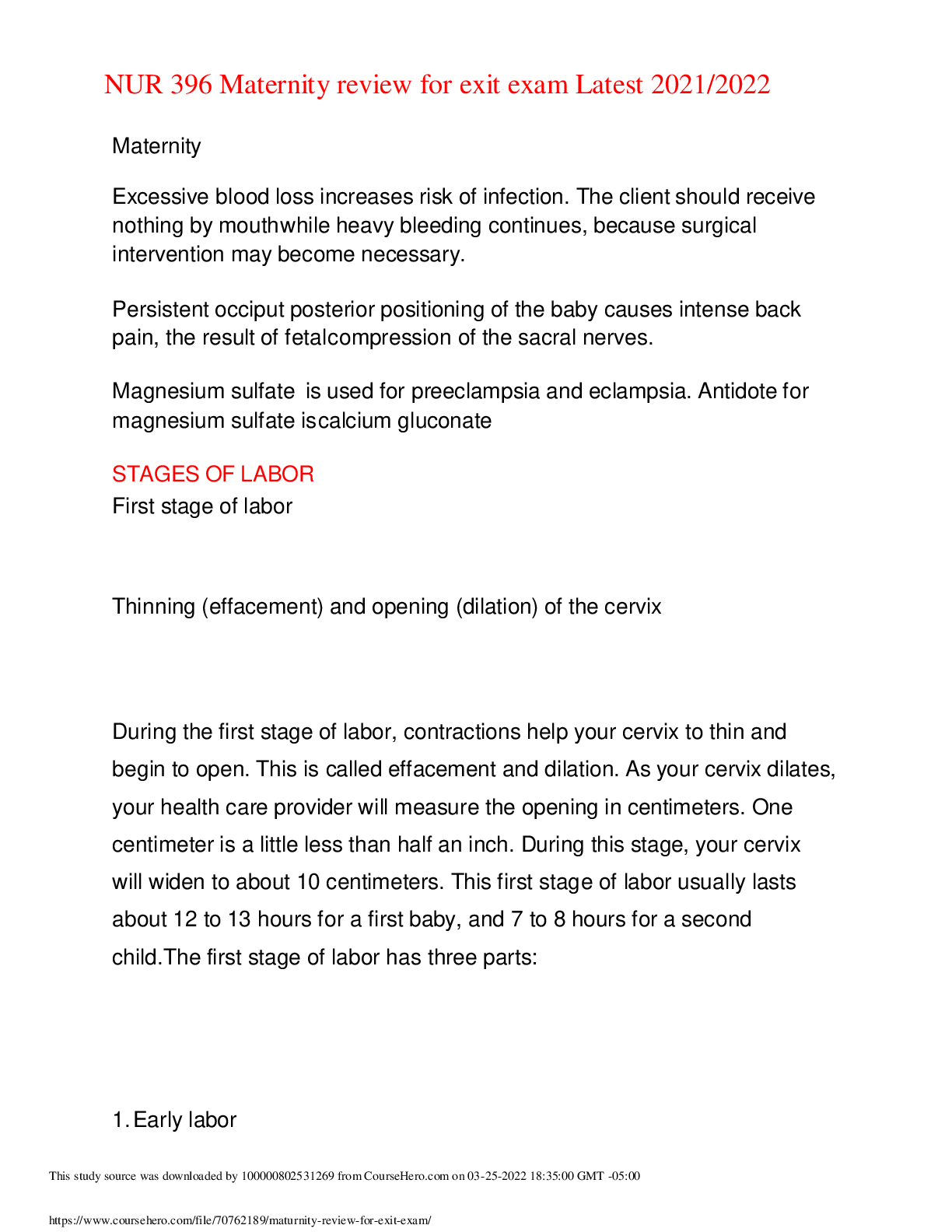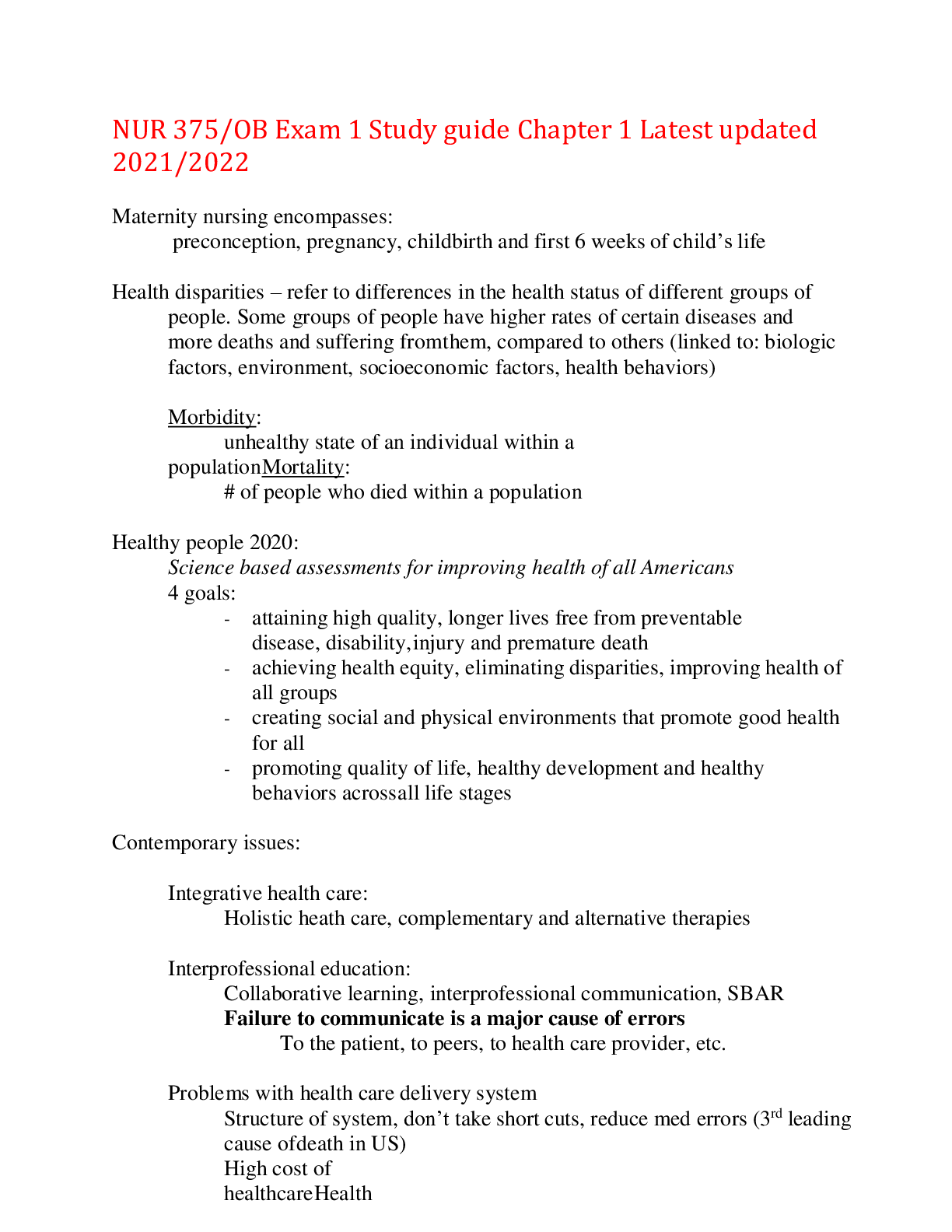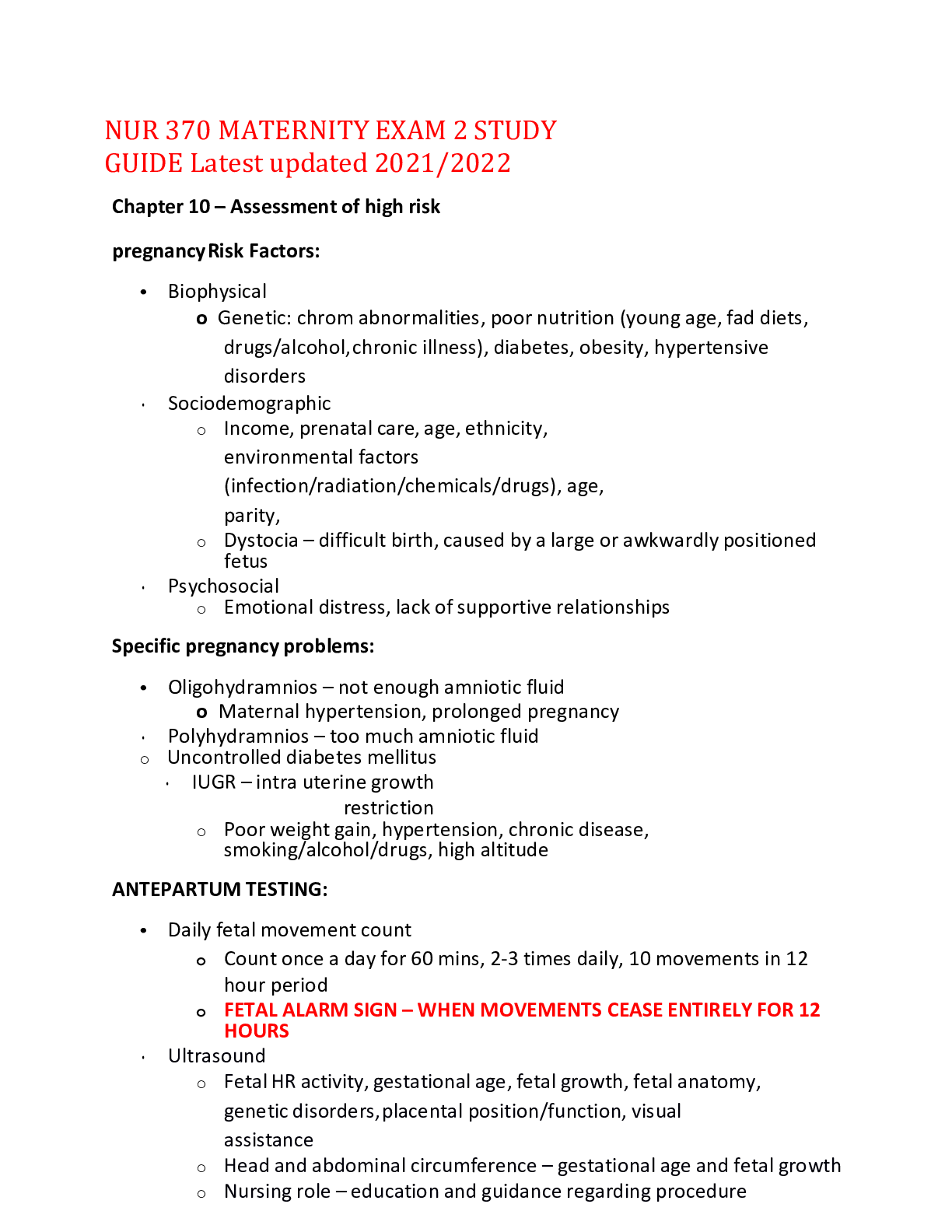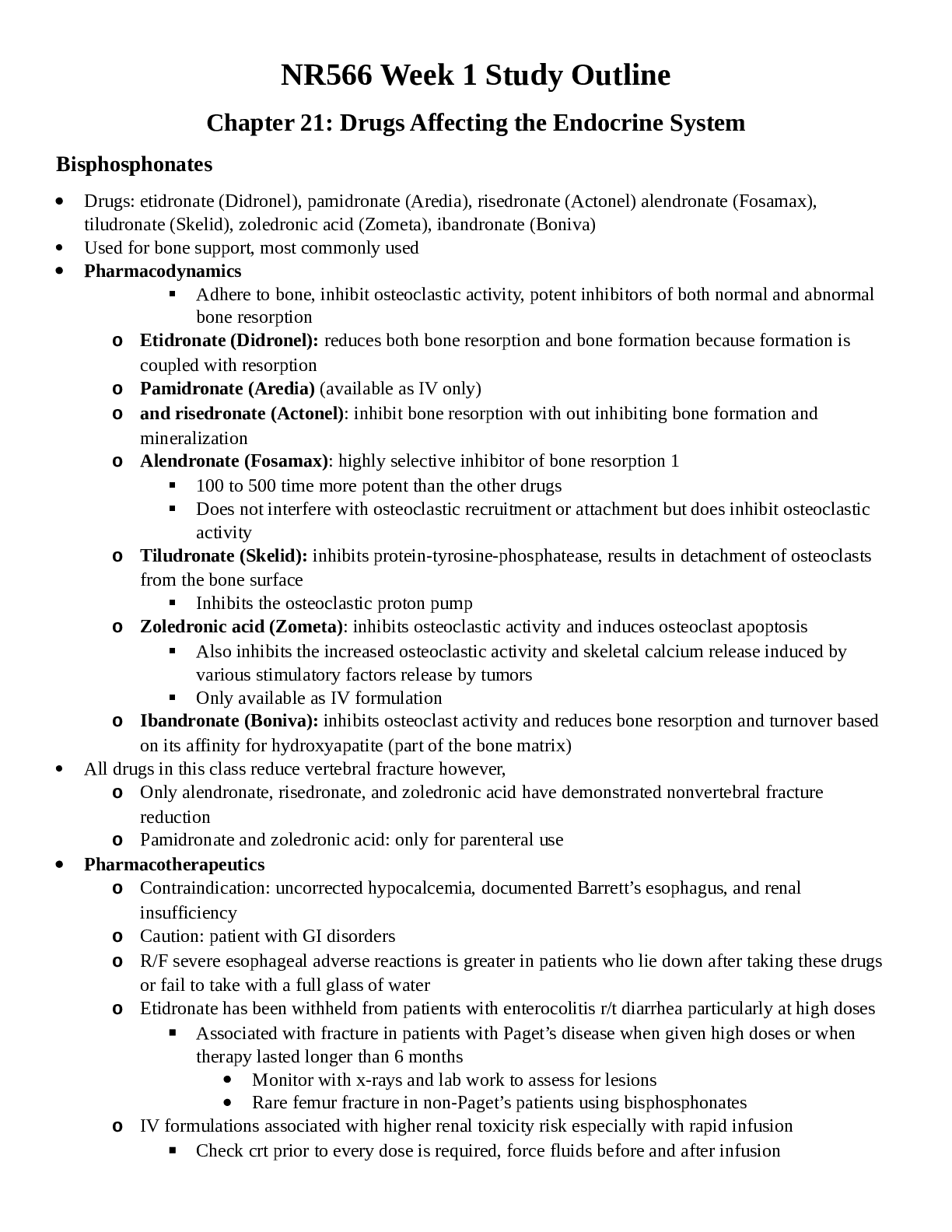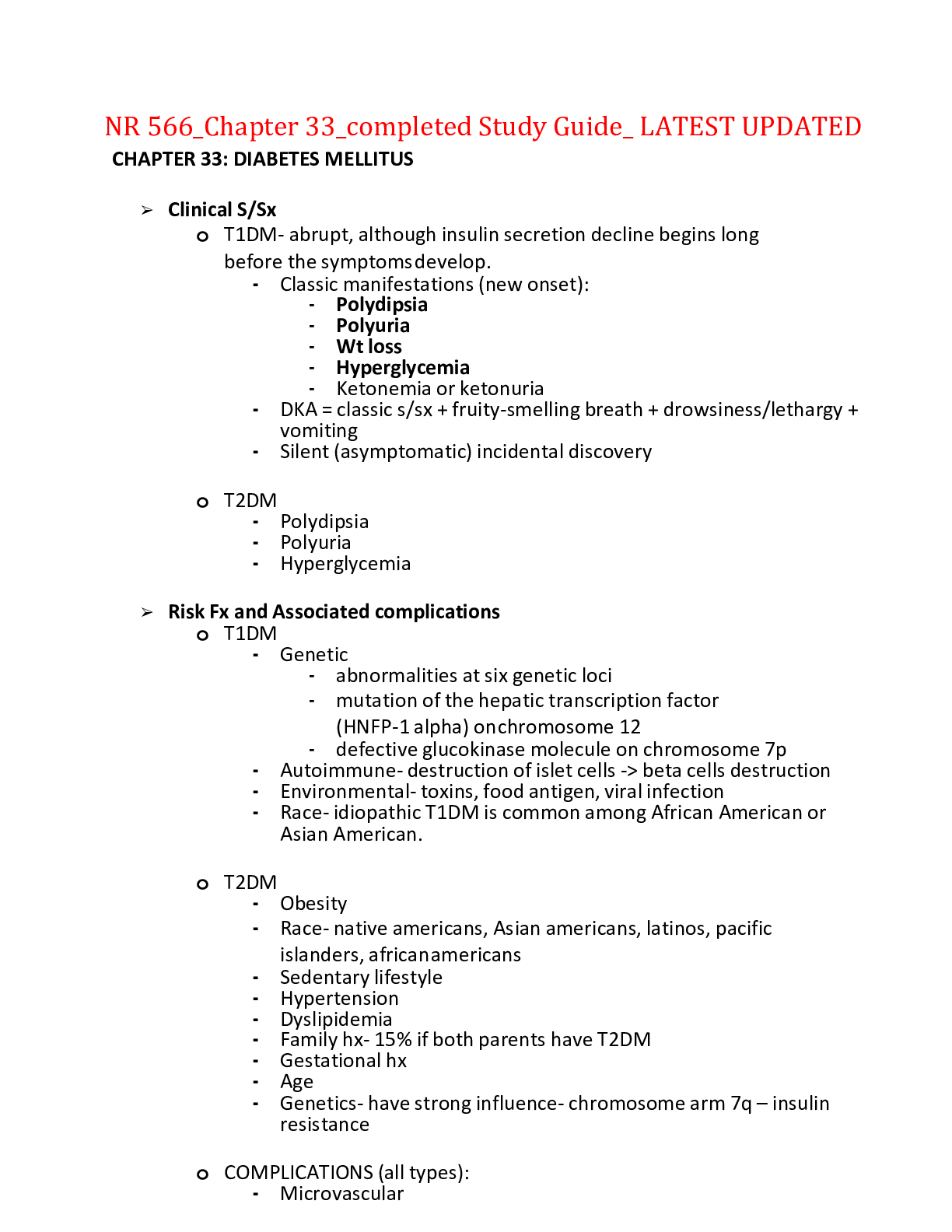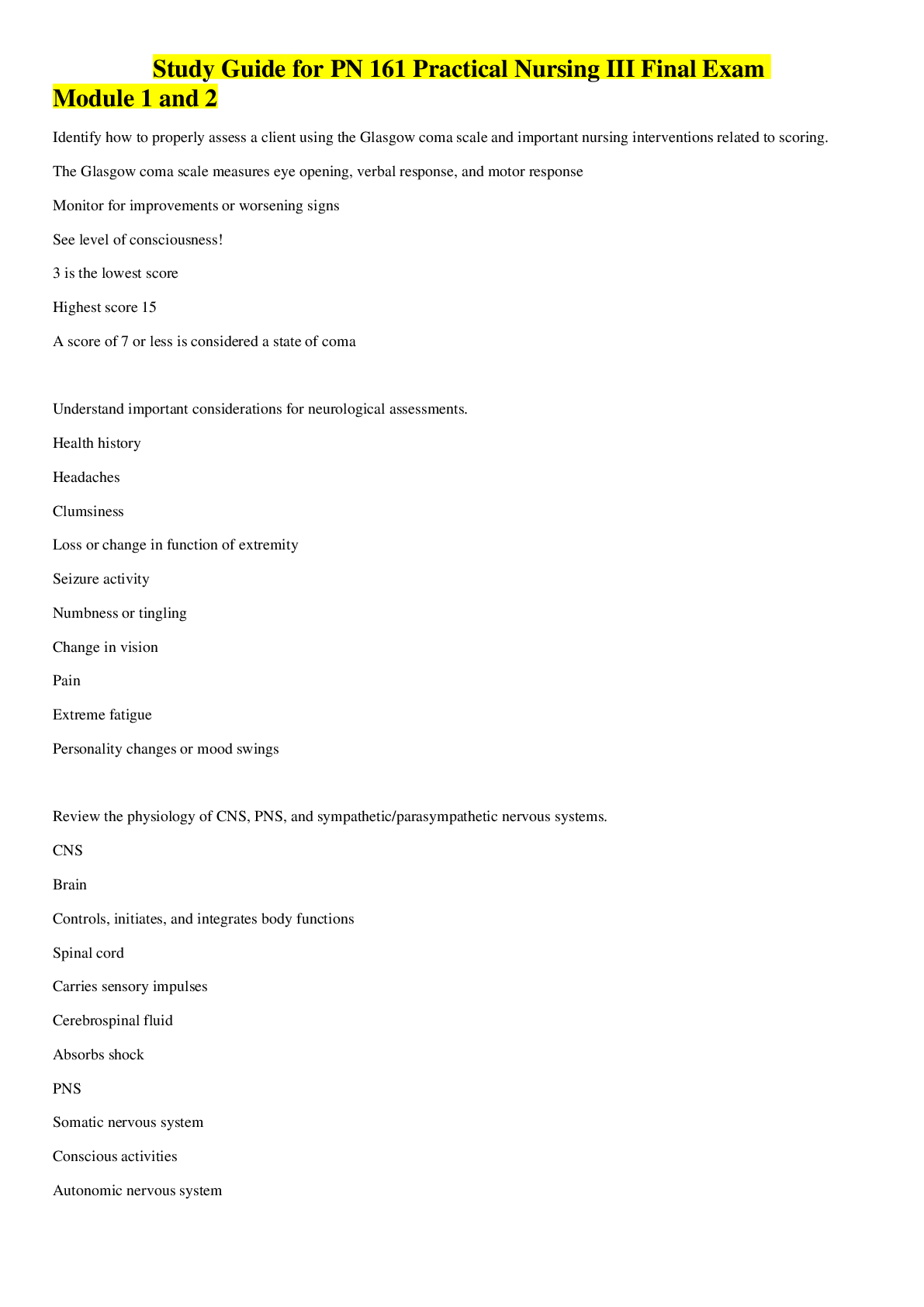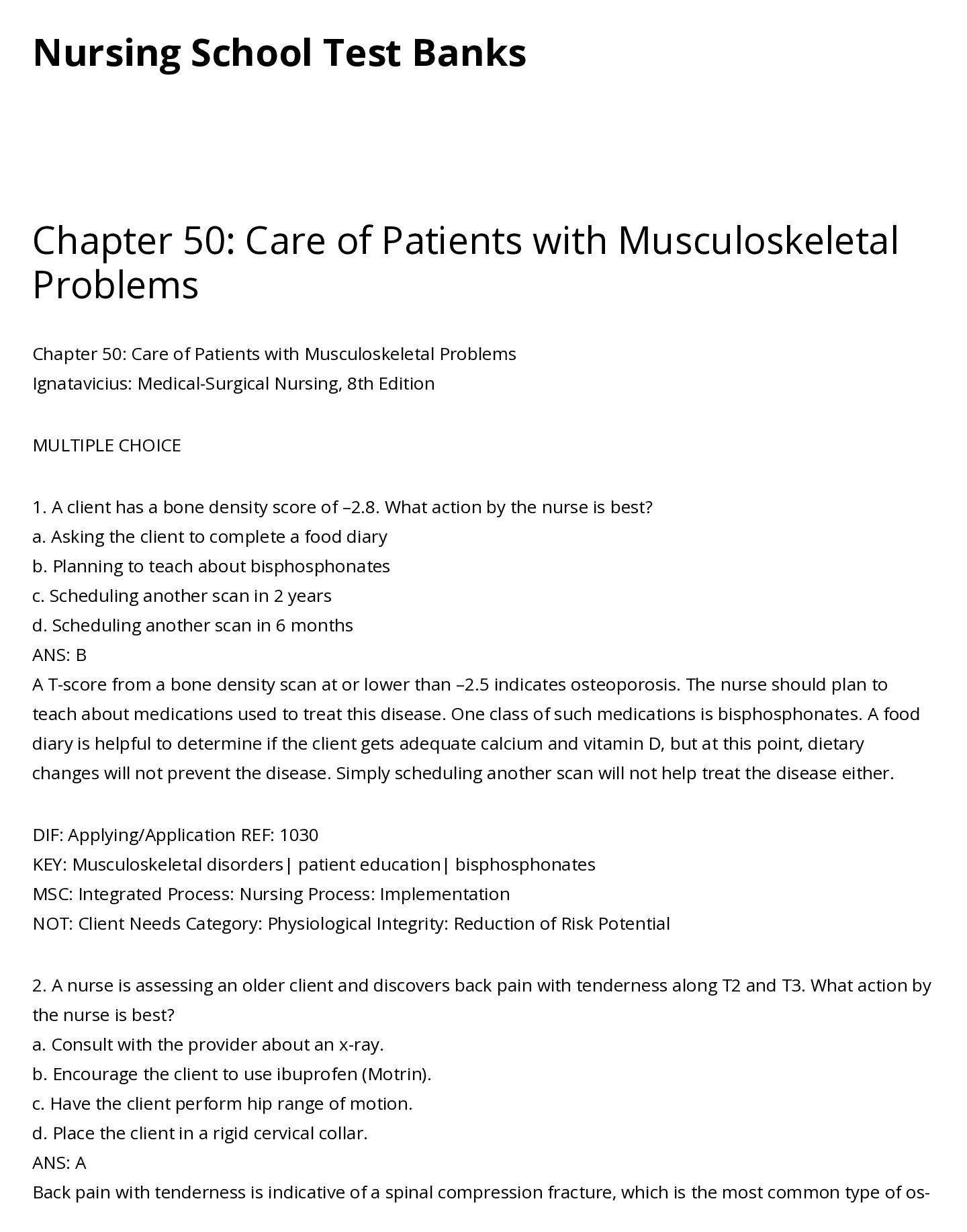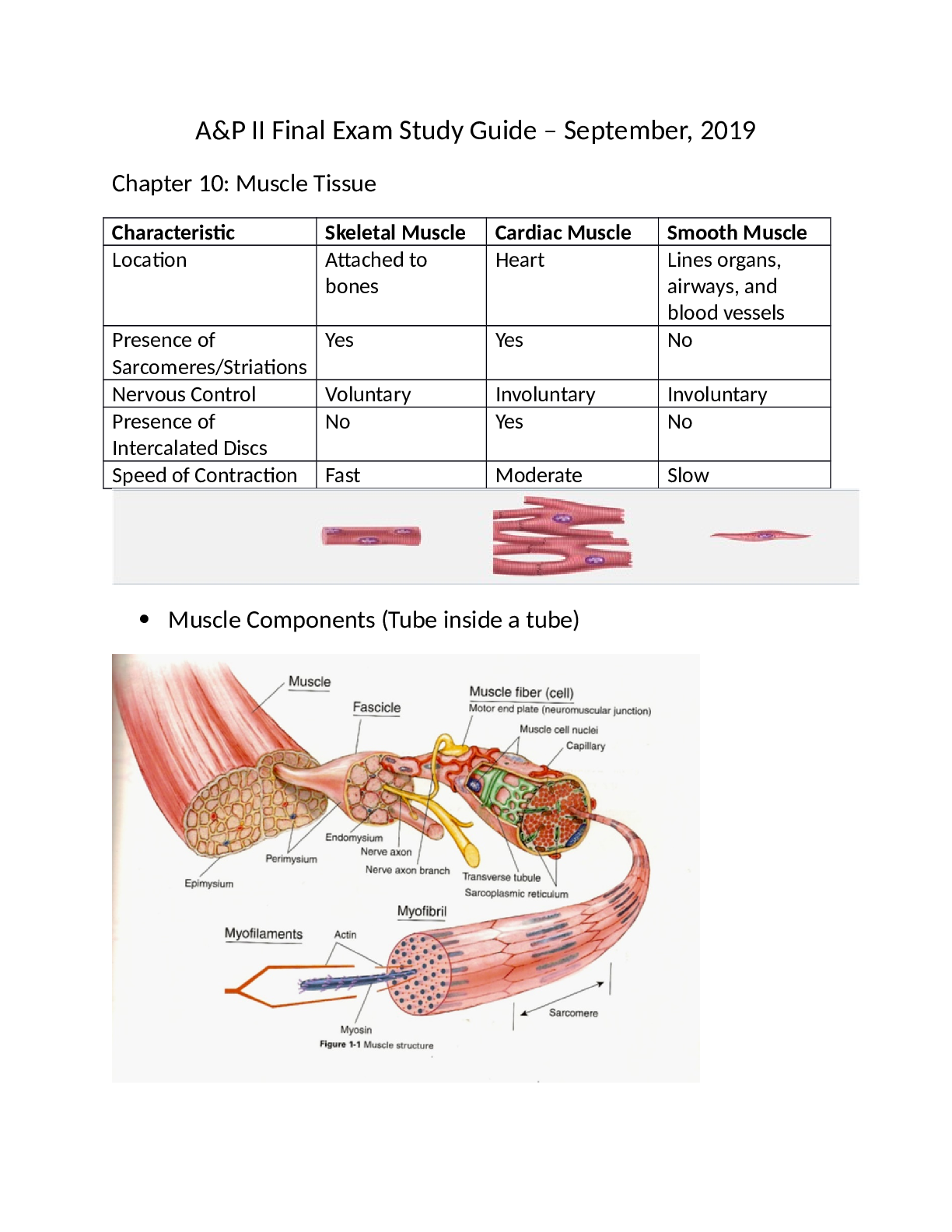*NURSING > STUDY GUIDE > NUR 2356/MDC II Final Exam Study Guide/Chapter 11: Care of Patients with Fluid and Electrolyte Balan (All)
NUR 2356/MDC II Final Exam Study Guide/Chapter 11: Care of Patients with Fluid and Electrolyte Balance,100% CORRECT
Document Content and Description Below
NUR 2356/MDC II Final Exam Study Guide/Chapter 11: Care of Patients with Fluid and Electrolyte Balance Hypervolemia S/S: pitting edema, increased HR/BP/HR, distended neck and hand veins, weight ga... in, SOB, lung crackles, pale/cool skin, decreased lab values, alter LOC Treatment: patient safety (assess every 2 hours for PE), assess for skin breakdown (skin care), provide supplemental O2 and position patient in semi-fowler’s to improve SOB, furosemide, fluid restriction, monitor daily weight and output, restrict Na/low sodium diet (water follows) Hypovolemia S/S: increased HR, orthostatic hypotension (increased risk for falls), weak/thready pulse, flattened neck/hand veins, increased RR, decreased turgor, warm/dry skin, dry mucous membranes, fever, decreased urine and increased concentration, increased lab values Treatment: fluid replacement (monitor pulse rate/quality and urine output of 30 ml/hr. during rehydration), antidiarrheals, antiemetics, antipyretics Calcium: Hypercalcemia Causes: hyperparathyroidism/hyperthyroidism, dehydration, use of thiazide diuretics, use of glucocorticoids, kidney failure, malignancy, excessive intake of calcium or vitamin D S/S: (EKG CHANGES FROM CLOT): cyanosis, pallor, EKG changes, increased risk for blood clots, profound muscle weakness, decreased DTR, decreased peristalsis/bowel sounds, constipation, kidney stone formation Calcium: Hypocalcemia Causes: lactose intolerance, Crohn’s disease, celiac disease, acute pancreatitis, ESKD, diarrhea, wound drainage, alkalosis (hyperventilation), hyperproteinemia S/S: (HYPERACTIVE CRAMPS): muscle spasms (“charley horses”), tetany, hyperactive reflexes, + Trousseau’s and Chvostek’s signs, arrythmias, weak/thready pulse, painful abdominal cramping, diarrhea, loss of bone density (osteoporosis), brittle/fragile bones (may break with slight trauma), confusion Normal Calcium (Ca+): 9.0-10.5mg/dL Potassium: Hypokalemia Causes: diuretics, alkalosis (hyperventilation), TPN, NPO, Cushing’s syndrome, vomiting, wound drainage, prolonged NG suctioning, heat-induced/excessive diaphoresis, corticosteroids, increased aldosterone S/S: (SLOW, LOW, + LETHAL): low/shallow respirations, muscle weakness, reduced DTR, leg cramps, limp muscles, lethal cardiac changes, low BP and HR, increased urine output, decreased bowel sounds (constipation) Normal Potassium (K+): 3.5-5.0 mEq/L Magnesium: Hypomagnesemia S/S: (HYPERACTIVE TWITCHING/SEIZING): HTN, dysrhythmias, constipation, hyperactive DTRs, involuntary movements, + Trousseau’s and Chvostek’s signs, Torsade’s de Pointes, weak respirations Normal Magnesium (Mg+): 1.8-2.6 mEq/L Sodium: Hyponatremia S/S: (SALT LOSS): confusion, trouble concentrating, seizures, stupor, muscle weakness/spasms, diminished DTRs, abdominal cramping, increased urine output, loss of appetite, shallow respirations, orthostatic hypotension, diarrhea Normal Sodium (Na+): 136-145 mEq/L Chapter 12: Care of Patients with Problems of Acid-Base Balance ABG Interpretation 1. Is the pH out of range? (in range and opposite direction-fully compensated; out of range and opposite direction-partially compensated; same direction-uncompensated) 2. Is the PaCO2 normal/out of range? (respiratory) 3. Is the HCO3 normal/out of range? (metabolic) 4. Match the one (PaCO2 or HCO3) that is the same as the pH. (acidosis or alkalosis) 5. Does the one that does not match/remains go in the opposite direction of pH? (compensation) 6. Is PaO2 and O2 sat out of range? (hypoxemia) Respiratory Acidosis/Metabolic Acidosis Interpretation: Kussmaul breathing, hyperkalemia, warm/dry/pink skin Causes: hypoventilation, asthma, COPD, pneumonia, in table below Respiratory Alkalosis/Metabolic Alkalosis Interpretation: hypocalcemia and hypokalemia, dizziness, twitching, tingling, increased HR and RR Causes: in table below Common Causes of Alkalosis Common Causes of Acidosis Metabolic Acidosis Overproduction of hydrogen ions Excessive oxidation of fatty acids: Diabetic ketoacidosis Starvation Hypermetabolism: Heavy exercise Seizure activity Fever Hypoxia, ischemia Excessive ingestion of acids: Ethanol or methanol intoxication Salicylate intoxication Under-elimination of hydrogen ions Kidney failure Underproduction of bicarbonate Kidney failure Pancreatitis Liver failure Dehydration Over-elimination of bicarbonate Diarrhea Respiratory Acidosis Under-elimination of hydrogen ions Respiratory depression: Anesthetics Drugs (especially opioids) Electrolyte imbalance Inadequate chest expansion: Muscle weakness Airway obstruction Alveolar-capillary block Acid-Base Assessment TEST ARTERIAL SIGNIFICANCE OF ABNORMAL FINDINGS pH 7.35-7.45 Increased: Metabolic alkalosis, loss of gastric fluids, decreased potassium intake, diuretic therapy, fever, salicylate toxicity, respiratory alkalosis, hyperventilation Decreased: Metabolic or respiratory acidosis, ketosis, renal failure, starvation, diarrhea, hyperthyroidism TEST ARTERIAL SIGNIFICANCE OF ABNORMAL FINDINGS PaO2 80-100 mm Hg Increased: Increased ventilation, oxygen therapy, exercise Decreased: Respiratory depression, high altitude, carbon monoxide poisoning, decreased cardiac output, hypoxia PaCO2 35-45 mm Hg Increased: Respiratory acidosis, emphysema, pneumonia, cardiac failure, respiratory depression Decreased: Respiratory alkalosis, excessive ventilation, diarrhea Bicarbonate 21-28 mEq/L Increased: Metabolic alkalosis, bicarbonate therapy Decreased: Metabolic acidosis, diarrhea, pancreatitis Chapter 22: Care of Patients with Cancer Tumor Lysis Syndrome (Oncological Emergency) S/S: early: lethargy, N/V, anorexia, flank pain, muscle weakness, cramps, seizures, edema, altered mental status; late: hyperkalemia, hyperuricemia, hyperphosphatemia, cardiac dysfunction Treatment: hydration (3000-5000ml per day) (isotonic solution, sodium bicarbonate) to dilute the concentration of the blood electrolytes, monitor daily weights and electrolytes, diuretics, kayexalate in extreme cases, may need dialysis SIADH (Oncological Emergency) S/S: hyponatremia, extreme muscle weakness, muscle cramps, loss of appetite, fatigue, weight gain, personality changes, decreased urine output and increased osmolarity (treatment effective: increased urine output, decreased osmolarity) Treatment: focuses on treating the condition and cause, hypertonic solution (2% or 5% NS), restrict fluid, increase sodium intake, immediate radiation/chemotherapy my cause enough tumor regression that ADH production returns to normal Chemotherapy MOA: chemical agents that are used to kill cancer cells, interferes with cell division and regulation, useful in treating metastatic/rapidly dividing cancers (palliative nurse), can be used independently or with other therapies Complications: extravasation (drug leaks into surrounding tissue), vesicants (chemicals that damage tissue on direct contact) S/S: temporary or permanent damage to normal tissues, chemo-induced N/V, alopecia, mucositis, stomatitis, cognitive changes, psychosocial issues, chemo-induced peripheral neuropathy, anemia, thrombocytopenia, infection (bone marrow suppression and neutropenia), bladder toxicity, anxiety, low activity level (tolerable activity) Patient Teaching: hand hygiene, stay at home as much as possible, personal hygiene, mouth care, PPE for oral/home chemotherapy (no direct skin contact with agent) Radiation Side Effects: acute or long-term site-specific skin changes (radiation dermatitis: redness and rash), alopecia, altered taste, loss of appetite (eat 1 hour before therapy, liquids between meals, bland carbs like cereal or crackers, avoid high-fat, cold/room temp. foods, sit up for 1 hour following), fatigue, xerostomia (dry mouth), photosensitivity, bone marrow suppression, tissue fibrosis and scarring Patient Teaching: skin care (pat dry, no washcloths), do not remove temporary ink markings, wash skin with mild soap and water/avoid scrubbing, avoid sun exposure, avoid alcohol-containing/aluminum- containing products, frequent/gentle mouth care, swabs (no toothbrushes), use saliva substitutes, regular dental visits, speech therapy, exercise, ensure good night sleep Surgical Treatment Complications: reduced function with organ loss, depression, altered appearance (scarring, disfigurement), reduced activity level, cancer remains Patient Teaching: encourage TCDB (turn, cough, deep breathing, spirometry), nutritional support (radiation on throat can cause speech/swallowing issues), early mobility, pain management, infection prevention, psychosocial support, rehabilitation (PT, OT) Infection Prevention: Low WBC Count o Avoid crowds and other large gatherings of people who might be ill. o Do not share personal toiletries such as toothbrushes, toothpaste, washcloths, or deodorant sticks with others. o If possible, bathe daily with an antimicrobial soap. If total bathing is not possible, wash the armpits, groin, genitals, and anal area twice a day with an antimicrobial soap. o Keep your toothbrush dry. o Wash your hands thoroughly with an antimicrobial soap before you eat and drink, after touching a pet, after shaking hands with anyone, as soon as you come home from any outing, and after using the toilet. o Follow the cancer center's instructions for eating fresh salads; raw fruits and vegetables; meat, fish and eggs; and pepper and paprika. o Wash dishes between use with hot, sudsy water or use a dishwasher. o Do not drink water, milk, juice, or other cold liquids that have been standing at room temperature for longer than an hour. o Do not reuse cups and glasses without washing. o Do not change pet litter boxes. o Take your temperature at least once a day and whenever you do not feel well. o Report any of these indications of infection to your oncologist immediately: o Temperature greater than 100° F (37.8° C) o Persistent cough (with or without sputum) o Pus or foul-smelling drainage from any open skin area or normal body opening o Presence of a boil or abscess o Urine that is cloudy or foul smelling or that causes burning on urination o Take all prescribed drugs. o Wear clean disposable gloves underneath gardening gloves when working in the garden or with houseplants. o Wear a condom when having sex. If you are a woman having sex with a male partner, ensure that he wears a condom. Chapter 53: Care of Patients with Oral Cavity Problems Stomatitis Patient Teaching (Diet): encourage frequent oral hygiene (rinse out mouth every 2 hours), avoid alcohol- containing products, select soft/bland/nonacidic foods, avoid spicy/hard/salty/acidic foods, cool/cold liquids (soothing), eat foods high in protein and vitamin C (promotes healing) Oral Cancer Risk Factors: increasing age (older than 40), tobacco use (cessation), alcohol use (avoid), HPV, poor oral hygiene, periodontal disease, poor nutrition, occupation (textile workers, plumbers, metal workers, coal miners), excessive sun exposure Chapter 54: Care of Patients with Esophageal Problems Hiatal Hernia Etiology: protrusion of stomach through esophageal hiatus of the diaphragm into the chest; rolling (obesity; reflux not present but volvulus/obstruction/strangulation high), sliding (structural defect, anemia, most common) Risk Factors: aging (weakening of diaphragm), smoking, obesity/straining S/S: sliding (heartburn, regurgitation/reflux, chest pain, dysphagia, belching: worsens after meal or when patient is supine), rolling (feeling of fullness/breathlessness after eating, feeling of suffocation, chest pain that mimics angina, laying down worsens) GERD Patient Teaching: limit/eliminate foods that decrease pressure and cause irritation (i.e.: peppermint, chocolate, alcohol, fatty foods, caffeine, carbonated beverages), restrict spicy and acidic foods (tomatoes, OJ), eat 4-6 small meals per day rather than 3 large ones, avoid eating at least 3 hours prior to bedtime, eat slowly/chew thoroughly, medication adherence (PPIs: omeprazole), weight loss, sit upright for 1 hour after eating, avoid NSAIDs Chapter 55: Care of Patients with Stomach Disorders Peritonitis: complication post abdominal surgery (high fever, rigid pain, tachycardia) S/S: abdomen is tender, rigid, and board-like; abdominal pain and distention, N/V, anorexia, diminishing bowel sounds, inability to pass flatus/feces (obstipation), high fever, tachycardia, dehydration, decreased urine output, hiccups, rebound tenderness, possible compromise in respiratory status Diagnostics (including labs): high WBC count (20,000 or above) and neutrophil count, blood culture studies, fluid and electrolyte balance, renal status, O2 sat, ABGs, abdominal x-ray, ultrasound PUD (H. pylori and NSAIDs) Diagnostics: epigastric tenderness (between umbilicus and xiphoid process), dyspepsia, abdominal pressure or fullness, urea breath test, stool antigen test, decreased H & H, chest and abdominal x-ray, EGD (major test) endoscopy Patient Teaching: medication adherence (drug regimen consists of a PPI and 2 antibiotics), avoid NSAIDs (use Tylenol/acetaminophen/analgesic), avoid spicy/acidic foods, sit upright after eating, stress reduction Duodenal Ulcers (type of peptic ulcer) S/S: N/V, dyspepsia (indigestion), abdominal pressure/fullness, abdominal pain (RLQ) exacerbated by food/NSAIDs/corticosteroids, epigastric tenderness (rigid, board-like abdomen with rebound tenderness and pain), pain usually occurs 90 mins.-3hrs. after eating, weight loss Gastritis Causes: H. pylori, long-term NSAID use, alcohol/coffee/caffeine/corticosteroid use, radiation therapy, smoking, autoimmune disorders Dumping Syndrome Patient Teaching: eat high-protein, high-fat, low-to-moderate carbs, low roughage, no milk/sweets/sugars, eliminate liquids with meals, eat small meals Gastric Cancer S/S: indigestion and abdominal discomfort (most common), feeling of fullness, epigastric/back retrosternal pain; advanced: weight loss, N/V, weakness, fatigue, iron deficiency anemia, enlarged lymph nodes, palpable epigastric masses, obstructive symptoms Surgical Treatment: radiation and chemotherapy, surgical resection/partial or total gastrectomy (preferred) Complications: decreased NG tube patency (epigastric pain, feeling of fullness, hiccups, tachycardia, hypotension) can result in acute gastric dilation, dumping syndrome (vertigo, tachycardia, syncope, sweating, pallor, palpitations), alkaline reflux gastropathy (bile reflux gastropathy), delayed gastric emptying, anemia, leukopenia, atrophic glossitis, aspiration from reflux, wound infection, bleeding, respiratory complications, DVT Patient Teaching: H. pylori and alcoholism increase risk, eat small/frequent meals, avoid drinking liquids with meals, avoid foods that cause discomfort, eliminate caffeine/alcohol, smoking-cessation, lie flat after eating for a short time, receive b12 injections as prescribed Differences Between Gastric and Duodenal Ulcers Age Usually 50 yrs. or older Usually 50 yrs. or older Gender Male/female ratio of 1.1:1 Male/female ratio of 1:1 General nourishment May be malnourished Usually well nourished Stomach acid production Normal secretion or hyposecretion Hypersecretion Occurrence Mucosa exposed to acid-pepsin secretion Mucosa exposed to acid-pepsin secretion Clinical course Healing and recurrence Healing and recurrence Pain Occurs 30-60 min after a meal; at night: rarely Worsened by ingestion of food Occurs 1.5-3 hrs. after a meal; at night: often awakens patient between 1 and 2 AM Relieved by ingestion of food Hemorrhage Hematemesis more common than melena Melena more common than hematemesis Recurrence Tends to heal and recurs often in the same location 60% recur within 1 yr.; 90% recur within 2 yrs. Surrounding mucosa Atrophic gastritis No gastritis Early vs. Advanced Gastric Cancer Chapter 56: Care of Patients with Non-inflammatory Intestinal Disorders Colon Cancer: CEA (tumor marker) S/S: common: rectal bleeding, anemia, change in stool consistency or shape; vomiting and changes in bowel elimination habits, fatigue, abdominal fullness, vague abdominal pain, unintentional weight loss Risk Factors: 50 years of age or older, genetic predisposition, personal/family history, predisposing conditions (familial adenomatous polyposis, Crohn’s disease, and ulcerative colitis) Patient Teaching: recommend annual screening (fecal occult blood test) for patients over 50; post-op: avoid lifting heavy objects or straining on defecation, avoid vigorous activity and driving for 4-6 weeks (open surgical approach), consume foods high in fiber and protein, avoid read meats and eat veggies, avoid foods that cause flatus (beans, eggs, carbonated beverages), odor (eggs, fish, garlic), and obstruction (nuts, raw carrots, popcorn); proper colostomy care (wound care nurse), s/s of complications Bowel Obstruction S/S: obstipation, mid-abdominal pain/cramping, vomiting Assessment: NG tube patency, placement, residual (COCA: color, odor, consistency, amount/volume), output at least every 4 hours, dry mucous membranes (provide oral care), pain and abdominal assessment (hyperactive bowel sounds=early; hypoactive bowel sounds=late) Chapter 57: Care of Patients with Inflammatory Intestinal Disorders Diverticulosis Complications: diverticulitis can result in rupture of the diverticulum with peritonitis, pelvic abscess, bowel obstruction, fistula, persistent fever or pain, or uncontrolled bleeding (bacteria in diverticula) S/S: usually asymptomatic (found incidentally on routine colonoscopy), pain or bleeding may develop, intermittent pain in LLQ, history of constipation, low-grade fever Ulcerative Colitis Complications: toxic megacolon, hemorrhage, dysplastic biopsy results, colon cancer Patient Teaching: report pale blue/dark color of stoma, skin care, support groups, manifestations of GI bleed (black, tarry stool), rest to reduce intestinal activity/provide comfort/promote healing Treatments: amino-salicylates, glucocorticoids, antidiarrheal drugs, immunomodulators; diet modification (low-fiber/residue, high-protein, high-calorie), avoid dairy/alcohol/caffeine/raw vegetables/carbonated beverages/pepper/nuts/corn/dried fruit/smoking, complementary therapies, surgery, colon removal, ileostomy, NPO with TPN for severe cases, steroids=hyperglycemia Side Effects: report N/V, anorexia, rash, headache with amino-salicylates; higher doses: hemolytic anemia, hepatitis, male infertility, agranulocytosis Crohn’s Disease Complications: weight loss, anemia, severe malabsorption issues, fistulas, anal fissures, peritonitis, bowel obstruction, nutrition and fluid imbalances/deficiencies (malabsorption) Appendicitis Patient Teaching: RUQ pain (McBurney’s Point: between anterior iliac crest and umbilicus), remain in semi-fowler’s to contain drainage, lay on side with knees drawn up to relieve abdominal tension Inflammatory Bowel Disease (Ulcerative Colitis and Crohn’s Disease) Treatment: glucocorticoid, loperamide (anti-diarrheal) Differential Features of Ulcerative Colitis and Crohn’s Disease FEATURE ULCERATIVE COLITIS CROHN'S DISEASE Location Begins in the rectum and proceeds in a continuous manner toward the cecum Most often in the terminal ileum, with patchy involvement through all layers of the bowel Peak incidence at age 15-25 yrs. old and 55-65 yrs. old 15-40 yrs. old Number of stools 10-20 liquid, bloody stools per day 5-6 soft, loose stools per day, not bloody Complications Hemorrhage Nutritional deficiencies Fistulas (common) Nutritional deficiencies Need for surgery Infrequent Frequent Complications of Ulcerative Colitis and Crohn’s Disease COMPLICATION DESCRIPTION Hemorrhage/perforation Lower GI bleeding results from erosion of the bowel wall. Abscess formation Localized pockets of infection develop in the ulcerated bowel lining. Toxic megacolon Paralysis of the colon causes dilation and subsequent colonic ileus, possibly perforation. Malabsorption Essential nutrients cannot be absorbed through the diseased intestinal wall, causing anemia and malnutrition (most common in Crohn's disease). Nonmechanical bowel obstruction Obstruction results from toxic megacolon or cancer. Fistulas In Crohn's disease in which the inflammation is transmural, fistulas can occur anywhere but usually track between the bowel and bladder, resulting in pyuria and fecaluria. Colorectal cancer Patients with ulcerative colitis with a history longer than 10 years have a high risk for colorectal cancer. This complication accounts for about one third of all deaths related to ulcerative colitis. Extraintestinal complications Complications include arthritis, hepatic and biliary disease (especially cholelithiasis), oral and skin lesions, and ocular disorders, such as iritis. The cause is unknown. Osteoporosis Osteoporosis occurs especially in patients with Crohn's disease. Chapter 58: Care of Patient with Liver Problems Cirrhosis S/S: early: fatigue, significant change in weight, anorexia, vomiting, liver/abdominal tenderness; late: jaundice, dry skin, rashes, petechiae, warm/bright red palms of hands, ecchymoses, spider angiomas, ascites (abdominal fluid), peripheral dependent edema, vitamin deficiency Diagnostics (including labs): bilirubin (itching), serum protein (decreased albumin), hematocrit, electrolytes, liver enzymes, elevated AST and ALT, LDH, alkaline phosphatase, prolonged PT/INR, elevated serum ammonia, WBCs, x-ray, ultrasound, MRI, biopsies Esophageal Varices Complications: bleeding varices (medical emergency), can result in shock from hypovolemia, loss of consciousness; hematemesis or melena (black, tarry stool) Hepatitis A Risk Factors: adults over 40 years of age, pre-existing liver disease (hepatitis), recent travel Transmission: fecal-oral route, contaminated food (shellfish) or water Hepatitis B Risk Factors: compromised immunity by disease/drug therapy, drug users, hepatitis carriers Transmission: blood-body fluids, unprotected sex with an infected partner, sharing needles/syringes, sharing razors/toothbrushes, accidental needlestick injuries, blood transfusions, hemodialysis, direct contact with blood or open sores, transfer during birth Hepatic Encephalopathy (result of severe liver disease) S/S: sleep and mood disturbances (labile), mental status changes, speech problems, altered LOC, impaired thinking process, neuromuscular problems Stages of Hepatic Encephalopathy • Subtle manifestations that may not be recognized immediately • Personality changes • Behavior changes (agitation, belligerence) • Emotional lability (euphoria, depression) • Impaired thinking • Inability to concentrate • Fatigue, drowsiness • Slurred or slowed speech • Sleep pattern disturbances Stage II • Continuing mental changes • Mental confusion • Disorientation to time, place, or person • Asterixis (hand flapping) Stage III • Progressive deterioration • Marked mental confusion • Stuporous, drowsy but arousable • Abnormal electroencephalogram tracing • Muscle twitching • Hyperreflexia • Asterixis (hand flapping) Stage IV • Unresponsiveness, leading to death in most patients progressing to this stage • Unarousable, obtunded • Usually no response to painful stimulus • No asterixis • Positive Babinski's sign • Muscle rigidity • Fetor hepaticus (characteristic liver breath—musty, sweet odor) • Seizures Abnormal Laboratory Findings in Liver Disease ABNORMAL FINDING SIGNIFICANCE Serum Enzymes Elevated serum aspartate aminotransferase (AST) Hepatic cell destruction, hepatitis Elevated serum alanine aminotransferase (ALT) Hepatic cell destruction, hepatitis (most specific indicator) Elevated lactate dehydrogenase (LDH) Hepatic cell destruction Elevated serum alkaline phosphatase Obstructive jaundice, hepatic metastasis Elevated gamma-glutamyl transpeptidase (GGT) Biliary obstruction, cirrhosis Bilirubin Elevated serum total bilirubin Hepatic cell disease Elevated serum direct conjugated bilirubin Hepatitis, liver metastasis ABNORMAL FINDING SIGNIFICANCE Elevated serum indirect unconjugated bilirubin Cirrhosis Elevated urine bilirubin Hepatocellular obstruction, viral or toxic liver disease Elevated urine urobilinogen Hepatic dysfunction Decreased fecal urobilinogen Obstructive liver disease Serum Proteins Increased serum total protein Acute liver disease Decreased serum total protein Chronic liver disease Decreased serum albumin Severe liver disease Elevated serum globulin Immune response to liver disease Other Tests Elevated serum ammonia Advanced liver disease or portal-systemic encephalopathy (PSE) Prolonged prothrombin time (PT) or international normalized ratio (INR) Hepatic cell damage and decreased synthesis of prothrombin Chapter 59: Care of Patients with Problems of Biliary System and Pancreas Pancreatitis Causes: biliary tract disease (gallstones), cystic fibrosis, abdominal surgery, smoking, alcoholism, genetics, renal failure, HIV infection, hypercalcemia, hyperlipidemia, hyperparathyroidism, pancreatic obstruction, trauma, premature activation of pancreatic enzymes that destroys ductal tissue and pancreatic cells (autodigestion and fibrosis result) S/S: acute: severe pain in the mid-epigastric area or LUQ (intense, boring/piercing, continuous), generalized jaundice, gray-blue discoloration of abdomen/flanks, weight loss; chronic: intense abdominal pain and tenderness, ascites, LUQ mass, respiratory compromise, steatorrhea (clay-colored stool), dark urine, diabetes mellitus/hyperglycemic (3 p’s) Diagnostics (including labs): increased serum amylase/trypsin/lipase levels, elevated serum glucose, decreased calcium and magnesium, WBCs, bilirubin, alkaline phosphatase, ALT, AST, abdominal ultrasound, contrast-induced CT scan Patient Teaching: NPO while in acute phase, Whipple procedure or pancreatomy (does not have to be both), avoid alcohol and caffeine-containing foods (tea, chocolate, soda, coffee), report jaundice/clay- colored stool/dark urine, same positioning as appendicitis Cholecystitis Patient Teaching: high-fiber, low-fat diet; small/frequent meals, lithotripsy (shock waves to breakdown stones) and drug therapy for pain management Teaching for Chronic Pancreatitis • Avoid things that make your symptoms worse, such as drinking caffeinated beverages. • Avoid alcohol ingestion; refer to self-help group for assistance. • Avoid nicotine. • Eat bland, low-fat, high-protein, and moderate-carbohydrate meals; avoid gastric stimulants such as spices. • Eat small meals and snacks high in calories. • Take the pancreatic enzymes that have been prescribed for you with meals. • Rest frequently; restrict your activity to one floor until you regain your strength. Causes of Diagnostic Laboratory Abnormalities in Acute Pancreatitis ABNORMAL FINDING CAUSE Cardinal Diagnostic Tests Increased serum amylase Pancreatic cell injury Elevated serum lipase Pancreatic cell injury Elevated serum trypsin Pancreatic cell injury Elevated serum elastase Pancreatic cell injury Other Diagnostic Tests Elevated serum glucose Pancreatic cell injury, resulting in impaired carbohydrate metabolism; decreased insulin release Decreased serum calcium and magnesium Fatty acids combined with calcium; seen in fat necrosis Elevated bilirubin Hepatobiliary obstructive process Elevated alanine aminotransferase (ALT) Hepatobiliary involvement Elevated aspartate aminotransferase (AST) Hepatobiliary involvement Elevated leukocyte count Inflammatory response Chapter 62: Care of Patients with Pituitary and Adrenal Glands Problems Addison’s (Adrenal Insufficiency) Causes: inadequate secretion of cortisol/ACTH, dysfunction of the hypothalamic–pituitary control mechanism, direct dysfunction of adrenal gland tissue, autoimmune disease, TB, AIDS, abdominal radiation therapy, metastatic cancer, pituitary tumors, long-term corticosteroid drug therapy S/S: anorexia, N/V, diarrhea, abdominal pain, weight loss (hypotension, hyponatremia, hypoglycemic, hyperkalemia, hypercalcemia), anemia Diagnostics (including labs): low serum cortisol, low fasting blood glucose, low sodium, elevated potassium, increased BUN levels, ACTH stimulation test Diabetes Insipidus Treatment: control of manifestations with drug therapy, desmopressin self-administration (oral, nasal), vasopressin through ADH (posterior pituitary), hydration Cushing’s Syndrome (Hypercortisolism, Hyperaldosteronism) Causes: hypersecretion by adrenal cortex caused by pituitary adenoma (most common) or glucocorticoid drug therapy (most at risk for infection) S/S: fat pads on the neck, back, and shoulders; enlarged trunk with thin arms and legs, round face (moon face), acne, HTN, hyperglycemia, loss of bone density, extreme muscle wasting, weight gain, buffalo hump, thinning skin, emotional lability/mood swings (does not feel like self) (reversible) Patient Teaching: infection prevention (hand hygiene, avoid crowds, influenza vaccine), monitor weight (report 3lb. weight gain in 1 week), adherence and side effects of hormone replacement Cushing’s Disease (Hypercortisolism, Hyperaldosteronism) S/S: same as syndrome, to diagnosis disease from syndrome: ACTH, may also have cortisol in urine, most commonly caused by pituitary adenoma Acromegaly S/S: overproduction of growth hormone in adults, enlargement of face/hands/feet, increased skeletal thickness, skin hypertrophy, liver/heart enlargement, thickened lips, coarse facial features, barrel-shaped chest, joint pain, hyperglycemia, sleep apnea Adrenal Insufficiency S/S Hypercortisolism (Cushing’s Disease/Syndrome) S/S Chapter 63: Care of Patients with Thyroid and Parathyroid Problems (calcium most related to thyroid) Thyroid Storm S/S: key symptoms: fever, tachycardia, systolic HTN; other symptoms: abdominal pain, N/V, diarrhea, anxious, tremors, restless, confused, psychotic, seizures leading to coma (caused by pregnancy, trauma, infection, stress, DKA) Treatment: maintain airway, promote adequate ventilation and gas exchange, reduce fever, stabilize hemodynamic status, do not give Synthroid/levothyroxine/thyroid meds Hypoparathyroidism Patient Teaching: consume foods high in calcium (grains/broccoli/kale)/low in phosphorus (no dairy, peas, meat, eggs, legumes), medication adherence, interventions to reduce anxiety (stress therapy) Hypothyroidism: TSH is high, T3 and T4 are low (myxedema coma, cold intolerance, weight gain, low HR) Hyperthyroidism: TSH is low in Grave’s, T3 and T4 are high (thyroid storm, heat intolerance, weight loss, exophthalmos, goiter) Emergency Care of Patient During Thyroid Storm Chapter 64: Care of Patients with Diabetes Mellitus DMI (autoimmune) Treatment: no cure, insulin therapy (rotate sites), nutrition interventions, pancreatic transplant Complications: hypoglycemia, hyperglycemia, somogyi phenomenon, cardiovascular disease, stroke, DKA, HHS, reduced immunity, cognitive dysfunction, peripheral neuropathy (feet) DMII (insulin resistant) Treatment: hyperglycemic control (manage blood sugars), blood glucose monitoring, nutrition interventions, exercise, drugs to lower blood glucose levels (insulin therapy only if blood glucose goals cannot be met with the use of 2-3 different antidiabetic drugs: Metformin and Glucophage, must have CT scan when on these meds, hold meds for 48 hours) Complications: DKA, HHS, hypoglycemia (too much insulin or too little glucose), reduced immunity, cardiovascular disease, cerebrovascular disease, diabetic retinopathy, diabetic nephropathy, sexual dysfunction, cognitive dysfunction Patient Teaching: low-calorie diet, increase physical exercise, weight loss, frequent eye exams DKA/Hyperglycemia (low insulin and high blood glucose) S/S: polyphagia (excess eating), polydipsia (excess thirst), polyuria (excess urination), fruity breath odor, risk for blood clots, ketone bodies, Kussmaul respirations, hemoconcentration, hypoxia, sunken/soft eyeballs, lethargic Treatment: fluid and electrolyte replacement (NS, hypotonic solution), acidosis management (sodium bicarbonate), regular insulin therapy Insulin Short-Acting/Regular: 2-4 hour peak Intermediate Acting/NPH: 8 hour peak Hypoglycemia (high insulin and low glucose) Treatment: glucose tablets/gel, fruit juice, carbs, calcium (if calcium is low, hypoglycemia occurs: twitching and tetany), glucagon and dextrose Patient Teaching: do not delay meal for more than 30 minutes, do not take insulin if not planning to eat, monitor glucose levels and adjust carb intake from readings, recommend medical-alert bracelet, consume 10-15g of carbs (recheck blood sugars in 15 minutes following), s/s (irritability, dizziness, confusion, lack of coordination, diaphoresis), eat prior to exercise Classification of Diabetes Mellitus Type 1 Diabetes (T1DM) • Beta-cell destruction leading to absolute insulin deficiency • Autoimmune • Idiopathic Type 2 Diabetes (T2DM) • Ranges from insulin resistance with relative insulin deficiency to secretory deficit with insulin resistance Other Conditions Resulting in Hyperglycemia • Genetic defects of beta-cell function • Genetic defects in insulin action • Pancreatic diseases (pancreatitis, trauma, cancer, cystic fibrosis, hemochromatosis) • Endocrine problems (acromegaly, Cushing's disease, hyperthyroidism, aldosteronism) • Drug- or chemical-induced hyperglycemia • Infections: congenital rubella, cytomegalovirus, human immune deficiency virus • Genetic syndromes associated with diabetes: Down syndrome, Klinefelter syndrome, Turner syndrome, Huntington disease, and others Gestational Diabetes Mellitus (GDM) • Glucose intolerance with onset or first recognition during pregnancy. (All pregnant women should be screened.) Differentiation of Type 1 and Type 2 Diabetes Features Type 1 Type 2 Former names Juvenile-onset diabetes Adult-onset diabetes Ketosis-prone diabetes Ketosis-resistant diabetes Insulin-dependent diabetes mellitus (IDDM) Non–insulin-dependent diabetes mellitus (NIDDM) Features Type 1 Type 2 Age at onset Usually younger than 30 yrs. old May occur at any age in adults Symptoms Abrupt onset, thirst, hunger, increased urine output, weight loss Frequently none; thirst, fatigue, blurred vision, vascular or neural complications Etiology Viral infection, autoimmunity Not known Pathology Pancreatic beta-cell destruction Insulin resistance Dysfunctional pancreatic beta cell Nutritional status Usually nonobese 60% to 80% obese Insulin All dependent on insulin Required for 20% to 30% Foot Care Instructions • Inspect your feet daily, especially the area between the toes. • Wash your feet daily with lukewarm water and soap. Dry thoroughly. • Apply moisturizing cream to your feet after bathing. Do not apply to the area between your toes. • Change into clean cotton socks every day. • Do not wear the same pair of shoes 2 days in a row and wear only shoes made of breathable materials, such as leather or cloth. • Check your shoes for foreign objects (nails, pebbles) before putting them on. Check inside the shoes for cracks or tears in the lining. • Purchase shoes that have plenty of room for your toes. Buy shoes later in the day, when feet are normally larger. Break in new shoes gradually. • Wear socks to keep your feet warm. • Trim your nails straight across with a nail clipper. Smooth the nails with an emery board. • See your physician or nurse immediately if you have blisters, sores, or infections. Protect the area with a dry, sterile dressing. Do not use adhesive tape to secure dressing to the skin. • Do not treat blisters, sores, or infections with home remedies. • Do not smoke. • Do not step into the bathtub without checking the temperature of the water with your wrist or thermometer. Optimal temperature is 95° F (35° C). Maximum temperature is 110° F (43° C). • Do not use very hot or cold water. Never use hot-water bottles, heating pads, or portable heaters to warm your feet. • Do not treat corns, blisters, bunions, calluses, or ingrown toenails yourself. • Do not go barefooted. • Do not wear sandals with open toes or straps between the toes. • Do not cross your legs or wear garters or tight stockings that constrict blood flow. • Do not soak your feet. Difference Between DKA and HHS DIABETIC KETOACIDOSIS (DKA) HYPERGLYCEMIC-HYPEROSMOLAR STATE (HHS) Onset Sudden Gradual Precipitating factors Infection Infection Other stressors Other stressors DIABETIC KETOACIDOSIS (DKA) HYPERGLYCEMIC-HYPEROSMOLAR STATE (HHS) Inadequate insulin dose Poor fluid intake Symptoms Ketosis: Kussmaul respiration, “rotting fruit” breath, nausea, abdominal pain Altered central nervous system function with neurologic symptoms Dehydration or electrolyte loss: polyuria, polydipsia, weight loss, dry skin, sunken eyes, soft eyeballs, lethargy, coma Dehydration or electrolyte loss: same as for DKA Laboratory Findings Serum glucose >300 mg/dL (16.7 mmol/L) >600 mg/dL (33.3 mmol/L) Osmolarity/ Osmolality Variable >320 mOsm/L (mOsm/kg) Serum ketones Positive at 1 : 2 dilutions Negative Serum pH <7.35 >7.4 Serum <15 mEq/L (mmol/L) >20 mEq/L (mmol/L) Serum Na+ Low, normal, or high Normal or low BUN >30 mg/dL (10 mmol/L); elevated because of dehydration Elevated Creatinine >1.5 mg/dL (60 mcmol/L); elevated because of dehydration Elevated Urine ketones Positive Negative [Show More]
Last updated: 1 year ago
Preview 1 out of 38 pages
Instant download

Buy this document to get the full access instantly
Instant Download Access after purchase
Add to cartInstant download
Reviews( 0 )
Document information
Connected school, study & course
About the document
Uploaded On
Feb 08, 2022
Number of pages
38
Written in
Additional information
This document has been written for:
Uploaded
Feb 08, 2022
Downloads
0
Views
31

.png)
